TCM Approaches to Cancer Treatment
In Traditional Chinese Medicine, "treatment according to syndrome patterns" is the premise for all clinical applications. TCM syndrome patterns are diagnosed from a full complexity of symptoms and dynamic balances of the patient, and they provide guidelines for physicians to select appropriate treatment method(s) as well as to predict the progress of a disease.
TCM physicians always design a comprehensive program for each cancer treatment. On one hand, physicians will employ a holistic method to uplift the general health condition that includes organ functioning, body resistance, immune functions, self-healing power and so on. On a more specific level, physicians may attack the cancer cells directly with specific herbs, such as Curcuma zedoaria (e zhu) in cervical cancer, Cephalotaxus fortunei (san jian shan) or natural indigo in leukemia, and Crotalaria sessiliflora (ye bai he) in skin cancers. Physicians will carefully balance the competing forces between body enhancement and cancer-fighting with treatment being adjusted according to the development of the disease.
The following are the major TCM approaches to cancer treatment:
General tonification
General tonification aims to replenish the blood and qi, fortify the organs and resume the yin yang balance of the body by methods like herbal prescriptions, acupuncture or acupressure. They can improve the body's ability to fight cancer, relieve complex symptoms and control cancer progression. It helps to reduce complications that arise in conventional therapies and increase the body's tolerance towards radiotherapy and chemotherapy. Studies have shown that many tonifying herbs have the ability to promote lymph cell production, activate the actions of T cells and phagocytosis, elongate the life of antibodies and increase the ratio of cAMP/cGMP. See "The Modulation Effect of Chinese Medicine." These immune activities are particularly necessary for cancer patients' bodies to be able to tackle the cancer. In clinical applications, physicians will target specific organs or deficient aspects of the body according to the individual's condition.
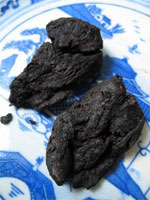 |
|
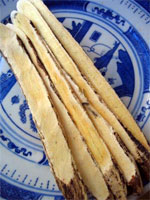 |
|
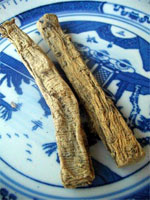 |
| Solomon's seal rhizome |
|
Astragalus |
|
Pilose asiabell root |
Clearing toxic heat
TCM believes that toxic heat is the major cause for cancer progression, especially in middle and late-stage patients. Toxic heat brings on swelling lumps, localized pain, fever, irritability, dry mouth and throat, constipation, yellowish urine, and foul discharges. Herbs with cooling properties can counteract the above reactions; these herbs will also, to a certain degree, inhibit the development of cancer cells. Some of the common herbs are:
bai hua she she cao |
Spreading hedyotis |
Hedyotis diffusa |
ban zhi lian |
Barbed skullcup |
Herba Scuttellariae barbatae |
yu xing cao |
Heartleaf houttuynia herb |
Herba houttuyniae |
long kui |
Black nightshade |
Solanum nigrum |
qi ye yi zhi hua |
Maryleaf paris |
Paris polyphylla |
dong ling cao |
Blushred rabdosia |
Rabdosia rubescens |
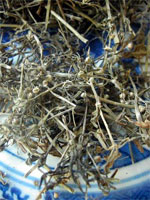 |
|
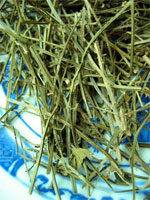 |
|
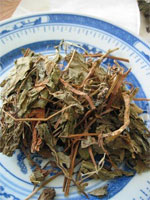 |
| Spreading hedyotis |
|
Barbed skullcup |
|
Heartleaf houttuynia herb |
Supplementing blood and dissipating stasis
It is believed that the high coagulate state of circulation helps cancer cells to travel along the blood vessels and embed in new areas and grow. TCM regards the condition as blood stasis, which is also associated with tumors, pain in a fixed location, a purplish tongue, purple discoloration of the skin, dry and rough skin, brittle nails and varicose veins. The above conditions can be improved through activating the blood flow and making the blood thinner, which also helps to make the tumor shrink as well as inhibit the growth of its surrounding connective tissues. Some common herbs are:
pu huang |
Cattail pollen |
Pollen Typhae |
dan shen |
Red sage root |
Radix Salviae Miltiorrhizae |
e zhu |
Zedoray rhizome |
Rhizoma Curcumae |
tao ren |
Peach kernel |
Semen Persicae |
ru xiang |
Bible frankincense |
Boswellia carteri |
ling xiao hua |
Trumpetcreeper flower |
Flos campsis |
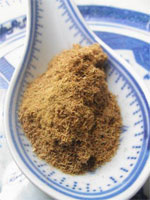 |
|
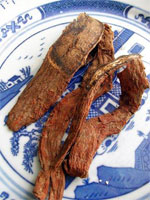 |
|
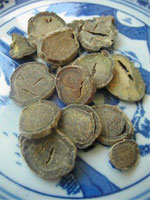 |
| Cattail pollen |
|
Red sage root |
|
Zedoray rhizome |
Dispersing phlegm to soften lumps
In TCM understanding, phlegm and dampness evils are not only at work during the early stages of cancer development. They keep acting inside the body throughout the whole course of the disease creating a series of complex problems. Dispersing phlegm and dampness is usually indicated for cancer patients presenting with massive lumps, chest and abdominal distention, nausea, vomiting, limb weakness and puffiness, even body fluid retention. Some common herbs are:
ban xia |
Pinellia tuber |
Rhizoma Pinelliae |
dan nan xing |
Bile arisaema |
Arisaema Cum Bile |
gua lou |
Mongolian snakegourd |
Fructus Trichosanthis |
shan ci gu |
Common pleione pseudobulb |
Pleione bulbocadioides |
zao jiao ci |
Chinese honeylocust spine |
Spina gleditsiae |
xia ku cao |
Common selfheal fruit-spike |
Spica prunellae |
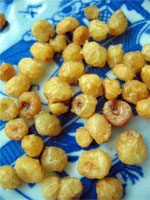 |
|
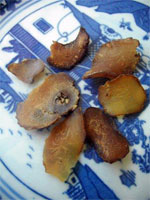 |
|
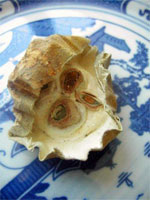 |
| Pinellia tuber |
|
Bile arisaema |
|
Mongolian snakegourd |
Detoxifying with toxic substances
Sometimes, the complex conditions exhibited by cancer patients may be due to a mix of various pathological toxins, which are difficult to resolve by simply eliminating methods, thus, physicians will then resort to utilize toxic substances to neutralize, the so-called "using poison as an antidote to poison". Actually, many of these toxic substances have been made into modern medicines that are used in chemotherapy in China. It is said that this approach has good results in reducing swelling and pain. Some common herbs for this treatment approach are:
wu gong |
Centipede |
Scolopendra |
ban mao |
Blister beetle |
Mylabris |
chan su |
Toad venom |
Venenum bufonis |
xiong huang |
Realgar |
Realgar |
ma qian zi |
Nux vomica |
Semen strychni |
teng huang |
|
Resina Garciniae |
External TCM anti-cancer methods
Apart from acupuncture and moxibustion, herbs can be made into different forms for external and topical applications, such as dressings, ointments, washing, steaming, inhalation, suppositories and enemas. They help to ease localized symptoms and can also be used to attack the cancer site directly. For example, herbal dressings may be applied for skin cancer or lymphatic metastases; inhalation methods may be used for lung cancer and nasopharyngeal carcinoma; liver cancer patients who have developed ascites (fluid retention inside the abdominal activity) may apply herbal dressings for clearing toxic heat and inducing urination. |